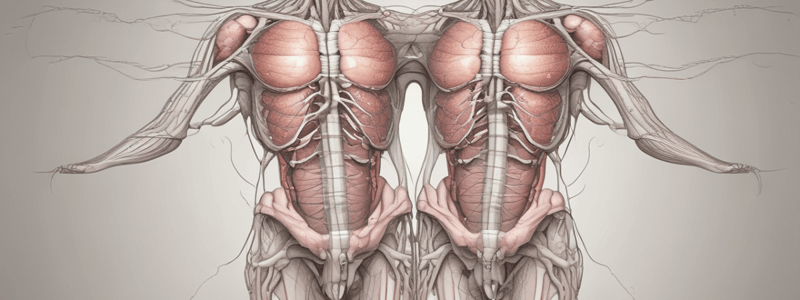Podcast
Questions and Answers
What is the primary function of the reproductive system?
What is the primary function of the reproductive system?
- Control of gonadotropin secretion
- Regulation of body temperature
- Production of reproductive cells and secretion of hormones (correct)
- Production of testosterone
What is the weight range of each testis?
What is the weight range of each testis?
- 5-10 g
- 15-20 g
- 10-15 g (correct)
- 20-25 g
What is the function of testosterone in the reproductive system?
What is the function of testosterone in the reproductive system?
- Spermatogenesis and sexual differentiation (correct)
- Control of gonadotropin secretion
- Regulation of body temperature
- Production of reproductive cells
What is the purpose of the scrotum?
What is the purpose of the scrotum?
What is the function of Sertoli cells?
What is the function of Sertoli cells?
What is the function of Leydig cells?
What is the function of Leydig cells?
What is the purpose of the rete testis?
What is the purpose of the rete testis?
What is the histology of the efferent duct?
What is the histology of the efferent duct?
What is the structure that connects the seminiferous tubules to the epididymis?
What is the structure that connects the seminiferous tubules to the epididymis?
What is the region of the sperm that contains DNA and has a helmet-like acrosome?
What is the region of the sperm that contains DNA and has a helmet-like acrosome?
What is the primary function of the pseudostratified columnar epithelium in the epididymis?
What is the primary function of the pseudostratified columnar epithelium in the epididymis?
What is the main function of the epididymis?
What is the main function of the epididymis?
Which structure is responsible for propelling spermatozoa through the epididymis?
Which structure is responsible for propelling spermatozoa through the epididymis?
What is the function of the microvilli (stereocilia) in the epididymis?
What is the function of the microvilli (stereocilia) in the epididymis?
Which part of the epididymis is the primary storage location of spermatozoa?
Which part of the epididymis is the primary storage location of spermatozoa?
What is the function of the vas deferens?
What is the function of the vas deferens?
What is the function of the seminal vesicles?
What is the function of the seminal vesicles?
What is the function of the prostate gland?
What is the function of the prostate gland?
Which structure connects the epididymis to the vas deferens?
Which structure connects the epididymis to the vas deferens?
What is the function of the ejaculatory duct?
What is the function of the ejaculatory duct?
Flashcards are hidden until you start studying
Study Notes
The Male Reproductive System
- The main task of the reproductive system is the production of reproductive cells and the secretion of hormones.
The Testis
- The testis is egg-shaped, 5 cm long, 3 cm wide, and 2.5 cm thick, and weighs 10-15 grams.
- It hangs in the scrotum and produces sperm, as well as contains endocrine cells that secrete hormones like testosterone.
- Testosterone is important for spermatogenesis, sexual differentiation, and control of gonadotropin secretion.
Seminiferous Tubules
- Seminiferous tubules are where sperm production takes place.
- They have a basement membrane with lamina propria, Sertoli cells, spermatogonia, primary spermatocytes, secondary spermatocytes, and spermatids.
- Leydig cells are interstitial cells that produce testosterone.
Sperm
- Sperm have three major regions: head, midpiece, and tail.
- The head contains DNA and has a helmet-like acrosome containing hydrolytic enzymes that allow the sperm to penetrate and enter the egg.
- The midpiece contains mitochondria spiraled around the tail filaments.
- The tail is a typical flagellum produced by a centriole.
Epididymis
- The epididymis has three functions: monitors and adjusts fluid produced by seminiferous tubules, recycles damaged spermatozoa, and stores and protects spermatozoa.
- It has a head, body, and tail, with the head receiving spermatozoa from efferent ductules.
- The epididymis body has pseudostratified columnar epithelium with microvilli, and the tail has loose connective tissue and a layer of smooth muscle.
Ductus Deferens (Vas Deferens)
- The ductus deferens is 40-45 cm long and begins at the tail of the epididymis, ascending through the inguinal canal.
- It curves inferiorly along the urinary bladder toward the prostate gland and seminal glands.
- The lumen enlarges into an ampulla, and the wall contains a thick layer of smooth muscle.
Ejaculatory Duct
- The ejaculatory duct is a short passageway (2 cm) at the junction of the ampulla and seminal gland duct.
- It penetrates the wall of the prostate gland and empties into the urethra.
Accessory Genital Glands
Seminal Vesicle
- The seminal vesicle is about 15 cm long with short side branches from the body.
- It is a tubular gland coiled and folded into a 5 cm by 2.5 cm mass.
- It is an extremely active secretory gland, producing 60% of semen volume, including fructose, fibrinogen, and prostaglandins.
Prostate Gland
- The prostate gland is a small, muscular organ, about 4 cm in diameter, which encircles the proximal portion of the urethra.
- It consists of 30-50 compound tubuloalveolar glands surrounded by smooth muscle fibers.
Studying That Suits You
Use AI to generate personalized quizzes and flashcards to suit your learning preferences.




